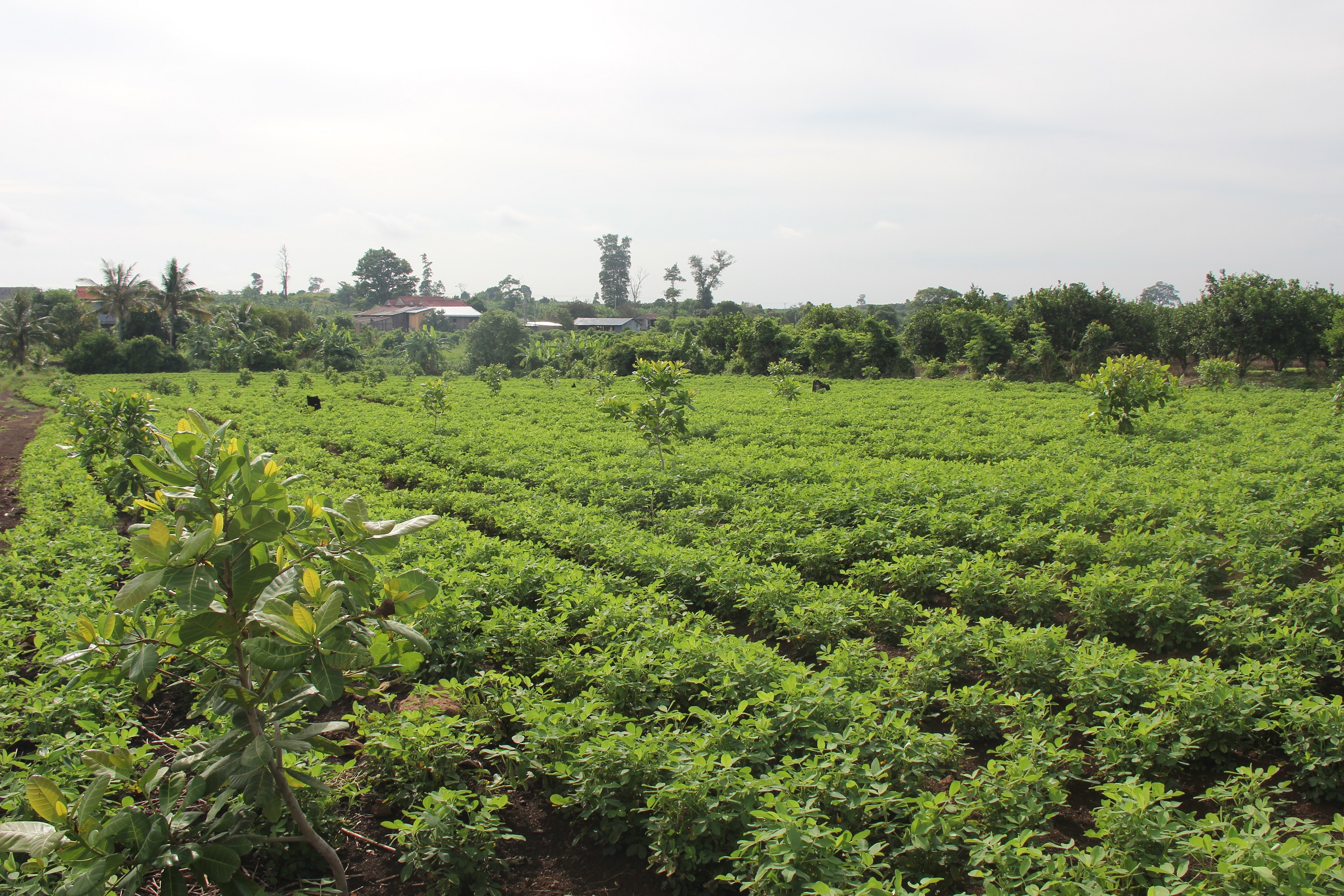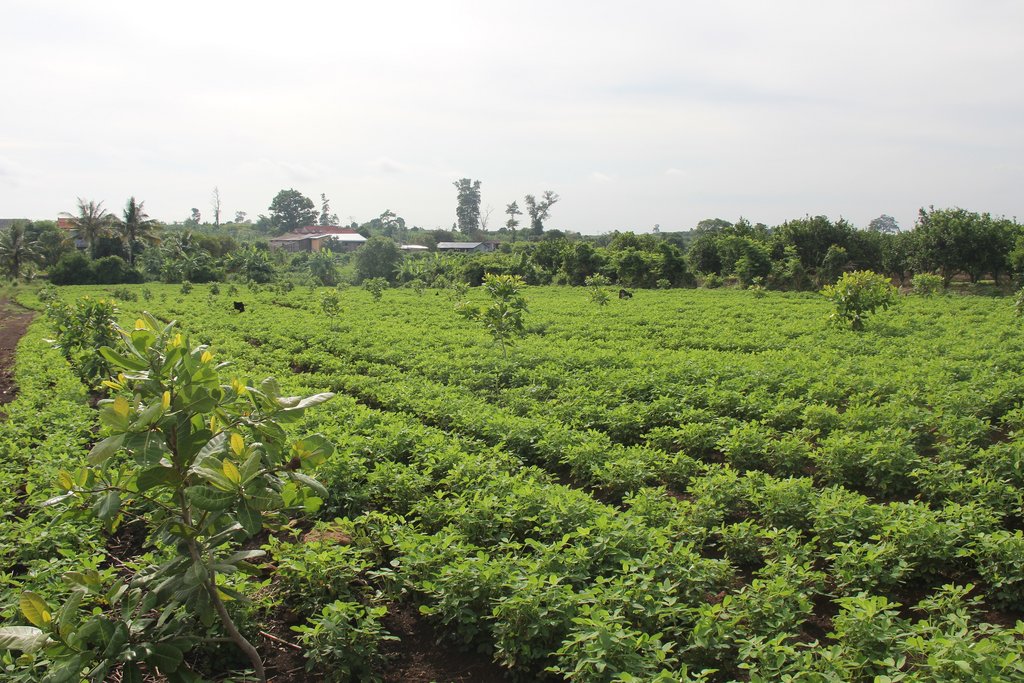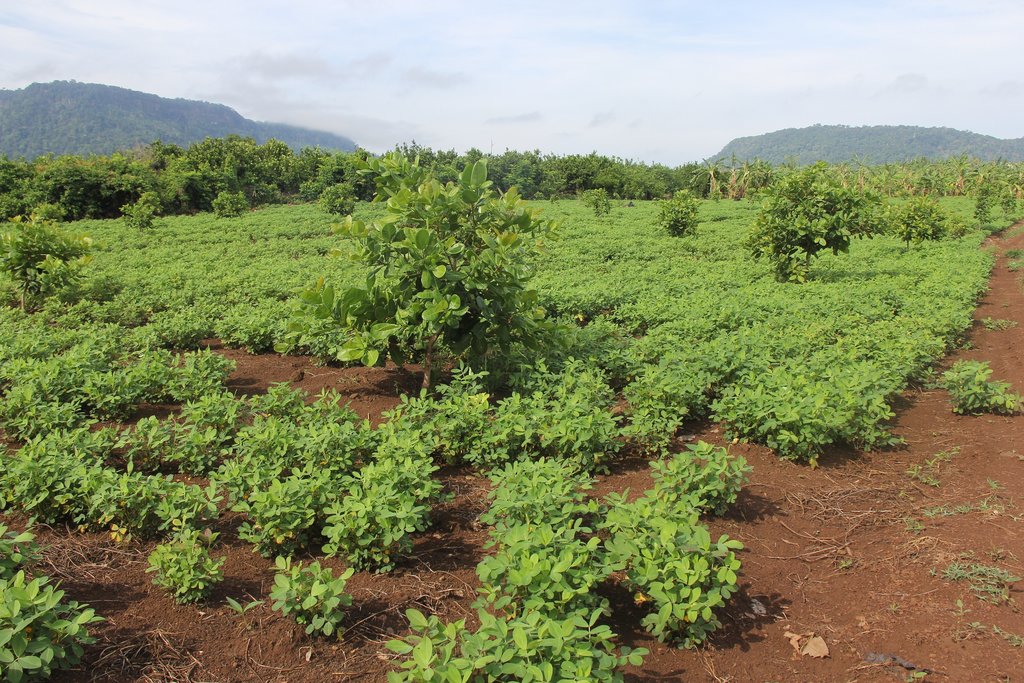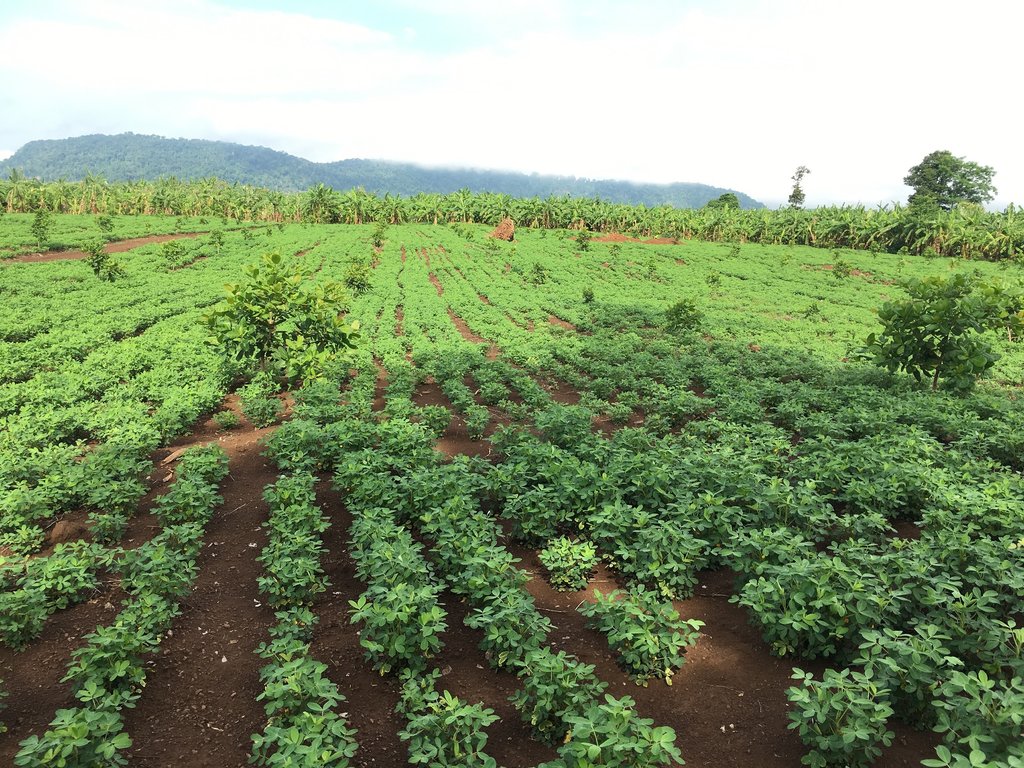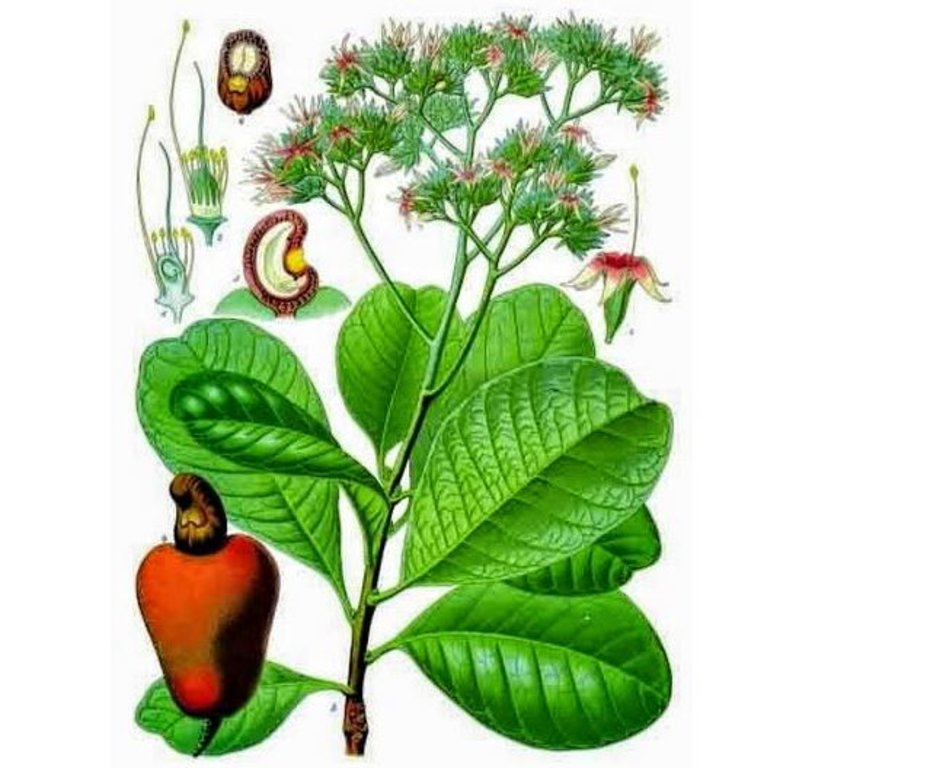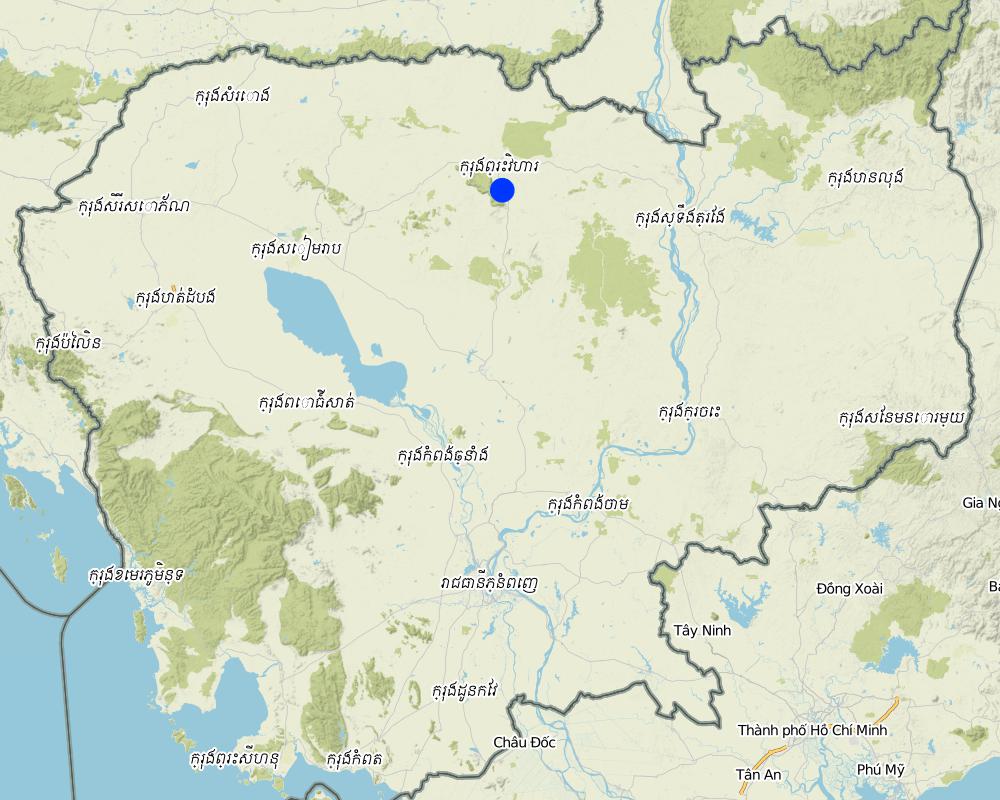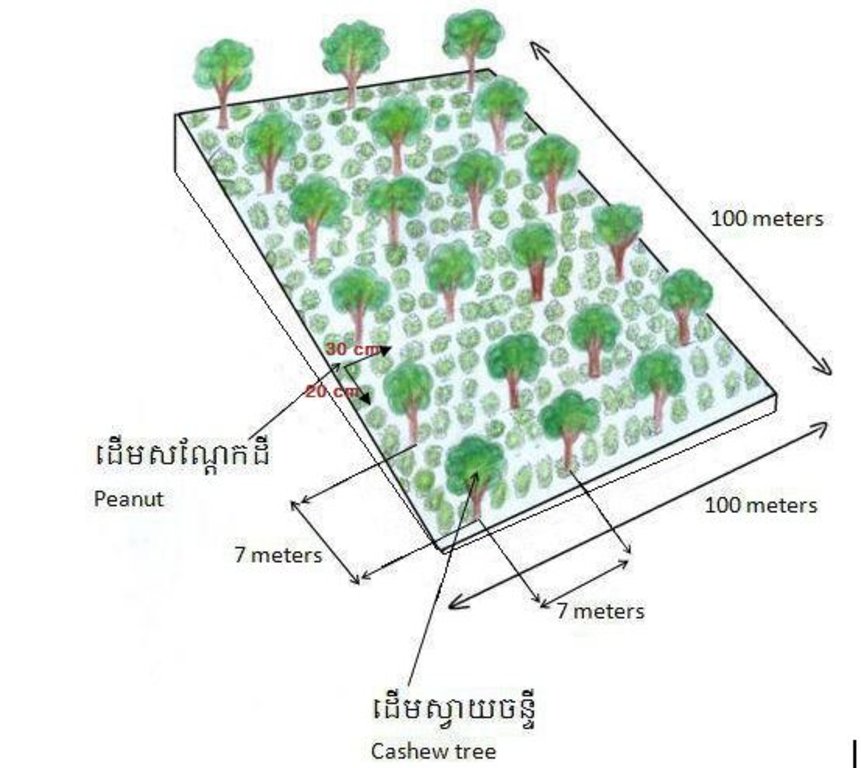Agroforestry-intercropping of peanut between cashew nut trees in upland areas [Cambodia]
- Creation:
- Update:
- Compiler: Navin Chea
- Editors: Sophea Tim, SOBEN KIM
- Reviewers: SO Than, Ursula Gaemperli, Alexandra Gavilano
Peanut and cashew nut trees
technologies_2315 - Cambodia
View sections
Expand all Collapse all1. General information
1.2 Contact details of resource persons and institutions involved in the assessment and documentation of the Technology
Key resource person(s)
Official from Provincial Department of Agriculture, Forestry and Fisheries, Preah Vihear:
Chief of District Office of Agriculture, Forestry and Fisheries, Kuleaen:
land user:
Uth Vin
Land User
Cambodia
Official from District Office of Agriculture, Forestry and Fisheries,Choam Khsant:
Prach Chhlath
Choam Khsant District Office of Agriculture, Forestry and Fisheries
Cambodia
Name of project which facilitated the documentation/ evaluation of the Technology (if relevant)
Scaling-up SLM practices by smallholder farmers (IFAD)Name of the institution(s) which facilitated the documentation/ evaluation of the Technology (if relevant)
Royal University of Agriculture (RUA) - Cambodia1.3 Conditions regarding the use of data documented through WOCAT
The compiler and key resource person(s) accept the conditions regarding the use of data documented through WOCAT:
Yes
1.4 Declaration on sustainability of the described Technology
Is the Technology described here problematic with regard to land degradation, so that it cannot be declared a sustainable land management technology?
No
2. Description of the SLM Technology
2.1 Short description of the Technology
Definition of the Technology:
Intercropping of annual cropping (peanut) with cashew trees farm aims to fill the free space of land between cashew trees. This kind of crop cover prevents soil erosion and improves soil fertility. At the same time peanut cultivation is economically interesting for the farmers as it enjoys high market demand.
2.2 Detailed description of the Technology
Description:
Peanut belongs to the family of Leguminosae (scientific name: Aarachishypogeae L) and contains many beneficial substances. The grain of peanut contains nutrients such as protein, calcium, vitamin B, and acid glutamine and its oil content at 40-60 percent is very high. The average yield of peanut is 0.73 ton/hectare (Cambodian Agricultural Research and Development Institute, 2006). Cambodians are growing it at household scale or on large farms.
Peanut can grow on many soil types especially on sandy soils mixed with alluvial soil (alluvial soils easily absorb water). The plant requires much sunlight as lacking light delays the plant growing. Adequate water is another need of the plant - not too much and not too little water. Peanuts grow from April to May and from September to October on the uplands and in November along the river after water has receded. The time of harvesting depends on the seed variety. Short term seeds can be harvested after 90 - 100 days and long term seeds after 120 - 140 days (Agritoday, 2016,Yayo, 2016).
Cashew belongs to the family of Asanardiaceae (scientific name: Anacardiumoccidentale L, Royal University of Agriculture, 2006). Cashew trees are grown in many tropical countries. The nutrition value of cashew nuts is high at about 500 calories per 100 gr. The first worthwhile harvest begins after 3 or 4 years (first yield 2.5 to 3 kilogram per tree) but can be started already with low yield after second year. But seven years after planting the yield of this evergreen tree remains constantly high nearly until it’s cut down after 25 years. In 2017, fresh cashew nuts got 8500 riel per kilogram (Agritoday, 2017).
As main purposes of the peanut as intercrop between cashew trees can be seen in the reduction of weed at 50 percentage and in the increase of additional income (MoE,2016).
Miss. Uth Vin living in the uplands of Preah Vihear province (Cambodia) is one of the farmers engaged in this agroforestry system. Before she started on some plots the land was degraded forest land. Firstly she converted it into a mono-cropping system (cassava, banana, mung bean, and soy bean). In 2016 she changed to cashew trees combined with peanuts.
The main benefits of this intercropping system are:
1. The technology meets the farmer’s ultimate economic need of enough cultivable land, as - to a certain extent - also degraded land can be cultivated by this technique and thus, create yield to improve the household income.
2. Before the farmers gets enough yields from cashew trees (after 3 years), peanuts provide them immediate income (yield after 3 month/2 harvests). On one hectare, peanut can provide a net income of 3,000,000 Riel (4000 Riel per kilogram).
As peanuts need enough sunlight, the intercropping must be stopped after 3 years, because the branches of the cashew trees provide too much shadow that is not convenient to peanut growing.
Beside the benefits already mentioned, the intercropping of peanut can improve soil fertility because the plant takes nitrogen from the air and ''fix'' it into the soil via its roots and by support of Rhizobium bacteria. After harvesting, the plant residues are ploughed into the soil as organic fertilizer. Thus, it is a very important green manure, which reduces the application of chemical fertilizers. Weed control at the first years of cashew growing is important as well. This also can be attained by the peanut cover plantation on the ground. Last but not least, peanut and cashew trees are crops which prevent soil erosion by water.
2.3 Photos of the Technology
2.5 Country/ region/ locations where the Technology has been applied and which are covered by this assessment
Country:
Cambodia
Region/ State/ Province:
BengKoang Village, PreahKhleang Commune,Tbaeng Mean Chey District, Preah Vihear Province.
Further specification of location:
The farm is 2 kilometers in distance from the mountain.
Specify the spread of the Technology:
- evenly spread over an area
Map
×2.6 Date of implementation
Indicate year of implementation:
2016
2.7 Introduction of the Technology
Specify how the Technology was introduced:
- through land users' innovation
Comments (type of project, etc.):
She asked other farmers and it was by self initiative. Before she tried to grow banana, but the cultivation was faced with diseases.
3. Classification of the SLM Technology
3.1 Main purpose(s) of the Technology
- improve production
- reduce, prevent, restore land degradation
- protect a watershed/ downstream areas – in combination with other Technologies
- create beneficial economic impact
3.2 Current land use type(s) where the Technology is applied
Land use mixed within the same land unit:
Yes
Specify mixed land use (crops/ grazing/ trees):
- Agroforestry

Cropland
- Annual cropping
- Perennial (non-woody) cropping
- Tree and shrub cropping
Annual cropping - Specify crops:
- legumes and pulses - beans
- legumes and pulses - soya
- oilseed crops - groundnuts
- root/tuber crops - cassava
Perennial (non-woody) cropping - Specify crops:
- banana/plantain/abaca
Tree and shrub cropping - Specify crops:
- cashew
Number of growing seasons per year:
- 2
Specify:
Peanut grows twice per year.
Is intercropping practiced?
Yes
If yes, specify which crops are intercropped:
Cashew intercropped by peanut

Forest/ woodlands
- Cashew Tree
Products and services:
- Fruits and nuts
3.3 Has land use changed due to the implementation of the Technology?
Has land use changed due to the implementation of the Technology?
- Yes (Please fill out the questions below with regard to the land use before implementation of the Technology)

Other
Specify:
Degraded forest
3.4 Water supply
Water supply for the land on which the Technology is applied:
- rainfed
3.5 SLM group to which the Technology belongs
- agroforestry
- improved ground/ vegetation cover
3.6 SLM measures comprising the Technology

agronomic measures
- A1: Vegetation/ soil cover
- A2: Organic matter/ soil fertility
3.7 Main types of land degradation addressed by the Technology

soil erosion by water
- Wt: loss of topsoil/ surface erosion

biological degradation
- Bc: reduction of vegetation cover

water degradation
- Ha: aridification
3.8 Prevention, reduction, or restoration of land degradation
Specify the goal of the Technology with regard to land degradation:
- prevent land degradation
Comments:
After harvest peanut, the green residues could be ploughed to bury in the soil to improve soil nutrient beneficial for crops.
4. Technical specifications, implementation activities, inputs, and costs
4.1 Technical drawing of the Technology
Technical specifications (related to technical drawing):
The implementation area of this technology is 10.000 square meters (width: 100 meters, length: 100 meters). 220 cashew trees has been planted on the plot. The space between the trees is 7 meters and the row distance in another 7 meters.
The pit for growing cashew trees is 30 centimeters in width, 30 long and 30 cm deep. The slope of the area is around 1.5-3 degree and it is about 2 kilometers from the mountain.
The peanut is planting by direct seedling by planting 3 seeds per hole( the hole is 3-4 cm in depth) by line with a hole spacing of 20 cm and a row spacing of 30 cm. In 10.000 square meters, the land users uses about 200 kg of peanut seeds.
Author:
Miss. Om Sovanny
Date:
05/05/2017
4.2 General information regarding the calculation of inputs and costs
Specify how costs and inputs were calculated:
- per Technology area
Indicate size and area unit:
1 hectare
If using a local area unit, indicate conversion factor to one hectare (e.g. 1 ha = 2.47 acres): 1 ha =:
1 hectare= 10000 square meters
other/ national currency (specify):
KHR
If relevant, indicate exchange rate from USD to local currency (e.g. 1 USD = 79.9 Brazilian Real): 1 USD =:
4000.0
Indicate average wage cost of hired labour per day:
20000
4.3 Establishment activities
| Activity | Timing (season) | |
|---|---|---|
| 1. | Ploughing the soil | January-March |
| 2. | Digging the pits for growing cashew trees | July |
| 3. | Applying organic fertilizer | July |
| 4. | Planting and growing peanut | July |
Comments:
Peanut is grown during rainy season. There is no water source in that area.
4.4 Costs and inputs needed for establishment
| Specify input | Unit | Quantity | Costs per Unit | Total costs per input | % of costs borne by land users | |
|---|---|---|---|---|---|---|
| Labour | Plough the soil | hectare | 1.0 | 60000.0 | 60000.0 | 100.0 |
| Labour | Growing peanut by direct seedling | Person-day | 40.0 | 20000.0 | 800000.0 | 100.0 |
| Equipment | Dig pits for growing cashew trees | Pit | 220.0 | 600.0 | 132000.0 | 100.0 |
| Equipment | Hoe | Piece | 10.0 | 35000.0 | 350000.0 | 100.0 |
| Equipment | Big knifes | Piece | 5.0 | 50000.0 | 250000.0 | 100.0 |
| Equipment | Spade | Piece | 10.0 | 35000.0 | 350000.0 | 100.0 |
| Plant material | Cashew trees | Tree | 220.0 | 3000.0 | 660000.0 | 100.0 |
| Plant material | Peanut seeds | Kilogram | 200.0 | 4700.0 | 940000.0 | 100.0 |
| Fertilizers and biocides | Fertilizer | Kilogram | 25.0 | 3000.0 | 75000.0 | 100.0 |
| Total costs for establishment of the Technology | 3617000.0 | |||||
| Total costs for establishment of the Technology in USD | 904.25 | |||||
Comments:
Loan from microfinance.
4.5 Maintenance/ recurrent activities
| Activity | Timing/ frequency | |
|---|---|---|
| 1. | Spray to improve cashew trees (leave) and pesticide | One time per week |
| 2. | Apply fertilizer on cashew tree root | 6 times per year |
| 3. | Weeding on cashew tree root | 3 times per year |
| 4. | Spay to improve peanut buddy and leave | When peanut grow for 20 days |
| 5. | Spay chemical fertilizer to improve flower and stem of peanut | 3 times per 3 moths ( one cycle of crop) |
| 6. | Weeding on peanut root | 2 times per three months |
| 7. | Harvesting peanut | After three months |
| 8. | Harvesting cashew nut | After 3 years |
4.6 Costs and inputs needed for maintenance/ recurrent activities (per year)
| Specify input | Unit | Quantity | Costs per Unit | Total costs per input | % of costs borne by land users | |
|---|---|---|---|---|---|---|
| Labour | Spray to improve fruit, leave and pesticide (Cashew) | Time | 32.0 | 40000.0 | 1280000.0 | 100.0 |
| Labour | Apply chemical fertilizer on cashew root | person-day | 36.0 | 20000.0 | 720000.0 | 100.0 |
| Labour | Weeding on cashew root. | Person-day | 45.0 | 20000.0 | 900000.0 | 100.0 |
| Labour | Spray chemical fertilizer on peanut to improve leave and stem. | time | 3.0 | 40000.0 | 120000.0 | 100.0 |
| Equipment | Pesticide spraying machine. | Piece | 1.0 | 400000.0 | 400000.0 | 100.0 |
| Equipment | Pesticide spraying equipment using by hand. | Piece | 1.0 | 20000.0 | 20000.0 | 100.0 |
| Fertilizers and biocides | Chemicals to improve cashew | Box | 2.0 | 25000.0 | 50000.0 | 100.0 |
| Fertilizers and biocides | Chemicals to improve stem, flower (peanut) | Box | 1.0 | 25000.0 | 25000.0 | 100.0 |
| Fertilizers and biocides | Chemicals to improve stem of peanut | package | 10.0 | 2500.0 | 25000.0 | 100.0 |
| Construction material | Buy a tent for sun drying peanuts | piece | 5.0 | 24000.0 | 120000.0 | 100.0 |
| Construction material | Buy bag for peanuts | piece | 700.0 | 1000.0 | 700000.0 | 100.0 |
| Construction material | Big basket for collecting peanuts | piece | 3.0 | 15000.0 | 45000.0 | 100.0 |
| Other | Weeding on peanut root. | time | 20.0 | 20000.0 | 400000.0 | 100.0 |
| Other | Harvesting peanut. | person-day | 70.0 | 20000.0 | 1400000.0 | 100.0 |
| Other | collect peanut seed. | Person-day | 60.0 | 20000.0 | 1200000.0 | 100.0 |
| Other | Hire labor to select peanut seed. | Person-day | 10.0 | 20000.0 | 200000.0 | 100.0 |
| Other | Hire labor to pick up cashew nut. | Kilogram | 1000.0 | 700.0 | 700000.0 | 100.0 |
| Total costs for maintenance of the Technology | 8305000.0 | |||||
| Total costs for maintenance of the Technology in USD | 2076.25 | |||||
Comments:
The maintenance costs for cashew trees are calculated for a one year period, but for peanut costs are calculated for one growing cycle of 3 month. At the time as this case study was done, the cashew trees were too young to provide the maximal expected amount of fuits, therefore the indicated harvest cost entered in this documentation bases on experience from other farmers in the neighborhood.
4.7 Most important factors affecting the costs
Describe the most determinate factors affecting the costs:
General high expenses for the establishment and for the maintenance of the technology. Cashew trees provide fruit in the 3rd year and whereas peanuts can be harvested within 3 months. Normally from the moment cashew trees provide fruits, farmers could not grow peanut on the same plot anymore.
5. Natural and human environment
5.1 Climate
Annual rainfall
- < 250 mm
- 251-500 mm
- 501-750 mm
- 751-1,000 mm
- 1,001-1,500 mm
- 1,501-2,000 mm
- 2,001-3,000 mm
- 3,001-4,000 mm
- > 4,000 mm
Specify average annual rainfall (if known), in mm:
1429.30
Specifications/ comments on rainfall:
Annual rainfall in 2015 was1429.3 mm and in 2014, the annual rainfall was 1647.3 mm.
Indicate the name of the reference meteorological station considered:
Ministry of Water Resources and Meteorology 2015
Agro-climatic zone
- sub-humid
5.2 Topography
Slopes on average:
- flat (0-2%)
- gentle (3-5%)
- moderate (6-10%)
- rolling (11-15%)
- hilly (16-30%)
- steep (31-60%)
- very steep (>60%)
Landforms:
- plateau/plains
- ridges
- mountain slopes
- hill slopes
- footslopes
- valley floors
Altitudinal zone:
- 0-100 m a.s.l.
- 101-500 m a.s.l.
- 501-1,000 m a.s.l.
- 1,001-1,500 m a.s.l.
- 1,501-2,000 m a.s.l.
- 2,001-2,500 m a.s.l.
- 2,501-3,000 m a.s.l.
- 3,001-4,000 m a.s.l.
- > 4,000 m a.s.l.
Indicate if the Technology is specifically applied in:
- not relevant
Comments and further specifications on topography:
Gentle slope, but mountains are only 2 kilometers in distance of the farm.
5.3 Soils
Soil depth on average:
- very shallow (0-20 cm)
- shallow (21-50 cm)
- moderately deep (51-80 cm)
- deep (81-120 cm)
- very deep (> 120 cm)
Soil texture (topsoil):
- fine/ heavy (clay)
Soil texture (> 20 cm below surface):
- fine/ heavy (clay)
Topsoil organic matter:
- medium (1-3%)
If available, attach full soil description or specify the available information, e.g. soil type, soil PH/ acidity, Cation Exchange Capacity, nitrogen, salinity etc.
The soil top layer is black with small boulders. The soil below surface is red without small boulders.
5.4 Water availability and quality
Ground water table:
< 5 m
Availability of surface water:
poor/ none
Water quality (untreated):
for agricultural use only (irrigation)
Is water salinity a problem?
No
Is flooding of the area occurring?
No
Comments and further specifications on water quality and quantity:
Rely entirely on rainfall.
5.5 Biodiversity
Species diversity:
- low
Habitat diversity:
- low
5.6 Characteristics of land users applying the Technology
Sedentary or nomadic:
- Sedentary
Market orientation of production system:
- commercial/ market
Off-farm income:
- 10-50% of all income
Relative level of wealth:
- average
Individuals or groups:
- individual/ household
Level of mechanization:
- manual work
- mechanized/ motorized
Gender:
- women
Age of land users:
- middle-aged
Indicate other relevant characteristics of the land users:
41 years old
5.7 Average area of land used by land users applying the Technology
- < 0.5 ha
- 0.5-1 ha
- 1-2 ha
- 2-5 ha
- 5-15 ha
- 15-50 ha
- 50-100 ha
- 100-500 ha
- 500-1,000 ha
- 1,000-10,000 ha
- > 10,000 ha
Is this considered small-, medium- or large-scale (referring to local context)?
- medium-scale
Comments:
Land for growing cashew trees is 10 hectares.
Land for growing banana is 14 hectares.
The ground around the house is 280 square meters (width 7 meters, length 40 meters).
5.8 Land ownership, land use rights, and water use rights
Land ownership:
- individual, titled
Land use rights:
- individual
Water use rights:
- open access (unorganized)
- Rely on rainfall
5.9 Access to services and infrastructure
health:
- poor
- moderate
- good
education:
- poor
- moderate
- good
technical assistance:
- poor
- moderate
- good
employment (e.g. off-farm):
- poor
- moderate
- good
markets:
- poor
- moderate
- good
energy:
- poor
- moderate
- good
roads and transport:
- poor
- moderate
- good
drinking water and sanitation:
- poor
- moderate
- good
financial services:
- poor
- moderate
- good
6. Impacts and concluding statements
6.1 On-site impacts the Technology has shown
Socio-economic impacts
Production
crop production
Comments/ specify:
Before, she only cultivated one crop e.g. banana, cassava or soy bean. Now by planting two crops and especially, by planting peanut which grows two times per year, she gets a higher production.
crop quality
Comments/ specify:
Monocropping is rather confronted with diseases that reduces the crop quality (e.g. banana is often prone by mealybugs), while the simultaneous cultivation of two crop species like cashew and peanut reduces diseases due to beneficial meachnismes set in motion (e.g. modification of the microclimate)
risk of production failure
Comments/ specify:
By the intercropping technology more than one crop grows on the agricultural plot, which reduces the risk production failure.
product diversity
Comments/ specify:
She plants now two crops simultaneously on the plot.
land management
Comments/ specify:
Intercropping could prevent soil erosion from water and in addition, it also reduces weeds.
Income and costs
expenses on agricultural inputs
Comments/ specify:
Despite of the reduced need of weeding, the growing of more than one crop variety needs a lot of fertilizer, labor force, and fine tuning of pesticide use.
farm income
Comments/ specify:
The market prices of cashew and peanuts are actually higher than the price of banana. Due to peanut planting in combination with the cashew growing the farmer avoids the income gap related to the late harvest of cashews (only in the 3rd year).
diversity of income sources
economic disparities
workload
Comments/ specify:
Land user has to maintain both peanut and cashew nut trees. Therefore she spend more time to apply fertilizers, pesticides to check all crops, if there is any disease or insect outbreak at all growing stages.
Socio-cultural impacts
food security/ self-sufficiency
Comments/ specify:
Peanut provides short term yield, before the cashew nut trees produce enough fruits.
health situation
Comments/ specify:
The nutrition value from both crops (cashew and peanut) is high and very beneficial to the human health.
cultural opportunities
Comments/ specify:
Many land users learn from each other to practice such kinds of Agroforestry systems. It is now popular in the upland areas of the Preah Vihear Province.
SLM/ land degradation knowledge
Comments/ specify:
The land user understands now the benefit of the intercropping system which avoids free space or bare land. She sees e.g., that the planting of peanuts between the trees avoids soil erosion by water and also, she recognizes that residues of peanut can improve soil fertility.
conflict mitigation
Comments/ specify:
The farmer was never involved in conflicts related to this technology. The farmers in this reagion are very open to share their knowledge.
Ecological impacts
Soil
soil moisture
Comments/ specify:
The soil cover by cashew trees and peanuts reduces the evaporation to the atmosphere and retain the moisture in the soil.
soil cover
Comments/ specify:
Due to the peanut plants which cover the ground around the cashew trees entirely.
soil compaction
Comments/ specify:
Peanut residues reduce soil compaction.
soil organic matter/ below ground C
Comments/ specify:
Peanut residue provide as source of organic matter which increases the activity of soil organisms and improves therefore the soil fertility.
Biodiversity: vegetation, animals
plant diversity
Comments/ specify:
Compared to the former monocropping, more than one crop is planted now (peanut and cashew nut trees).
invasive alien species
Comments/ specify:
Unknown disease occured on banana leaves turning them yellow. It might come from unknown viruses.
beneficial species
Comments/ specify:
The peanut residues increases the food source for decomposing soil organisms and therefore the number of beneficial species such as earthworms, ant, termites etc. raised.
pest/ disease control
Comments/ specify:
Less pest and disease due to the beneficial meachnism set in motion in the soil and on the microclimate by the intercropping of cashew trees and peanuts.
6.3 Exposure and sensitivity of the Technology to gradual climate change and climate-related extremes/ disasters (as perceived by land users)
Gradual climate change
Gradual climate change
| Season | increase or decrease | How does the Technology cope with it? | |
|---|---|---|---|
| annual temperature | increase | moderately | |
| seasonal temperature | wet/ rainy season | increase | well |
| seasonal temperature | dry season | increase | moderately |
| annual rainfall | increase | moderately | |
| seasonal rainfall | wet/ rainy season | decrease | moderately |
Comments:
The rain is not regular, sometimes is very much rain and sometimes not very much rain. Peanut grow during rainy season.
6.4 Cost-benefit analysis
How do the benefits compare with the establishment costs (from land users’ perspective)?
Short-term returns:
positive
Long-term returns:
very positive
How do the benefits compare with the maintenance/ recurrent costs (from land users' perspective)?
Short-term returns:
positive
Long-term returns:
very positive
6.5 Adoption of the Technology
- > 50%
Of all those who have adopted the Technology, how many did so spontaneously, i.e. without receiving any material incentives/ payments?
- 91-100%
6.6 Adaptation
Has the Technology been modified recently to adapt to changing conditions?
No
6.7 Strengths/ advantages/ opportunities of the Technology
| Strengths/ advantages/ opportunities in the land user’s view |
|---|
| Gain an additional income from the peanuts which can be harvested already within three months. |
| Provide an additional income before the cashew trees produce fruit. This can be used to help cover expenditure on crop maintenance and other daily expenses. |
| Strengths/ advantages/ opportunities in the compiler’s or other key resource person’s view |
|---|
| Peanuts are a short term crop which can be harvested within 3 months already. |
| Growing crops on the open space of land prevent soil erosion caused by water and wind. |
| Peanuts are the kind of crop that improves soil fertility and makes the soil not compact, as after harvesting, the peanut residue is ploughed into the soil. |
6.8 Weaknesses/ disadvantages/ risks of the Technology and ways of overcoming them
| Weaknesses/ disadvantages/ risks in the land user’s view | How can they be overcome? |
|---|---|
| Require a lot of labor for maintenance, such as spraying against pest and use of chemicals to improve leaves and stems. | Hire labor |
| Weaknesses/ disadvantages/ risks in the compiler’s or other key resource person’s view | How can they be overcome? |
|---|---|
| The cropping heavily relies on rainfall. | Dig a well or pond for water storage which could reduce the risk of crop failure during periods of drought. |
| The cultivation of a short term crop such as peanuts can only be done before the cashew trees become more sizable. After three or four years the cashew trees will provide too much shade and so it is not possible to continue to grow this short term crop. | Grow crops that do not need a lot of sunlight such as turmeric or galanga etc. |
7. References and links
7.1 Methods/ sources of information
- field visits, field surveys
- interviews with land users
2 persons
- interviews with SLM specialists/ experts
4 persons
- compilation from reports and other existing documentation
9
When were the data compiled (in the field)?
05/05/2017
7.2 References to available publications
Title, author, year, ISBN:
Cambodian Agricultural Research and Development Institute. (2006). Farmer Notes. Peanut growing technology., Year 5th,.
Available from where? Costs?
Cambodian Agricultural Research and Development Institute. Free of charge
Title, author, year, ISBN:
MoE. (2016). Agroforestry System “ Enhancing Climate Change Resilience of Rural Communities Living in Protected Areas in Cambodia .”
Available from where? Costs?
Ministry of Environment, Cambodia. Free of charge
Title, author, year, ISBN:
Royal University of Agriculture. (2006). cashew tree management. In Khmer.
Available from where? Costs?
Royal University of Agriculture. Mr. Khoun Eang and Mr. Pagnasoley. Free of charge
7.3 Links to relevant online information
Title/ description:
Agritoday. (2016). Peanut
URL:
Retrieved October 30, 2017, from http://agritoday.com/techniques/article/1413.html
Title/ description:
Agritoday. (2017). តម្លៃគ្រាប់ស្វាយចន្ទីស្រស់បានកើនឡើងប្រមាណ ៣០ភាគរយ
URL:
Retrieved October 30, 2017, from http://agritoday.com/news/article/2677.html
Title/ description:
Chouk Khmer. (2017). Cashew trees
URL:
Retrieved October 30, 2017, from https://choukhmer.wordpress.com/2010/12/10/cashew-tree/
Title/ description:
Reaksmey Kampuchea Newspaper. (2017). បច្ចេកទេសដាំសណ្តែកដី
URL:
Retrieved October 30, 2017, from http://www.rasmeinews.com/បច្ចេកទេសដាំសណ្តែកដី/
Title/ description:
Saang. (2017). Cashew crop
URL:
Retrieved October 30, 2017, from https://sroksaang.blogspot.com/2015/02/blog-post_20.html
Title/ description:
Yayo. (2016). ការដាំសណ្តែកដីតាមបែបធម្មជាតិ
URL:
Retrieved October 30, 2017, from http://vayofm.com/news/detail/60014.html
Links and modules
Expand all Collapse allLinks
No links
Modules
No modules


